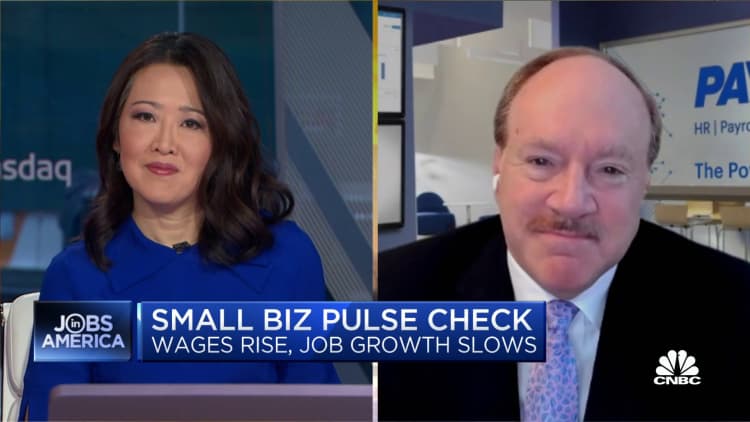The U.S. Federal Reserve elevated its benchmark rate of interest by 75 foundation factors to a spread of 1.5%-1.75% in June — the most important improve since 1994. Fed Chair Jerome Powell (above) flagged there may very well be one other price hike in July.
Mary F. Calvert | Reuters
The Federal Reserve raised its benchmark rates of interest by 75 foundation factors on Wednesday, the most recent in a collection of price hikes supposed to chill the economic system and produce down inflation. For all People, greater rates of interest carry weighty monetary implications. Important Avenue enterprise homeowners are not any exception, as the upper rates of interest will circulation via to the price of enterprise loans from lenders together with nationwide, regional and neighborhood banks, in addition to the Small Enterprise Administration’s key 7(a) mortgage program.
Much more vital could also be how the financial slowdown being engineered by the Fed influences client demand and the expansion outlook for Important Avenue. With the odds of recession mounting in consequence, at the very least partially, of the current collection of Fed price hikes, the price to be paid by Important Avenue is not restricted to an even bigger month-to-month debt curiosity cost and better price on new loans. The largest problem is a enterprise lending market that will shortly dry up as banks pull again on loans to preserve capital and restrict threat, and an more and more smaller proportion of enterprise homeowners meet stricter credit score necessities.
The Federal Reserve is probably going not carried out but with its price hikes after the Wednesday determination, with extra will increase anticipated once more in September and later in 2022. Here’s what small enterprise lending specialists say entrepreneurs needs to be enthusiastic about as they face each greater lending prices and the danger of a slower-growing economic system.
1. Borrowing prices will probably be greater, however nonetheless coming off historic lows
Rates of interest for enterprise loans, at one level final yr, dipped beneath 4%. That did not final, and the typical small enterprise mortgage is on its method to as excessive as 8%, however it is very important keep in mind that borrowing prices stay very low relative to historical past. One other 75 foundation factors from the Fed just isn’t insignificant, and it’ll circulation via the financial institution lending market.
“When the Fed begins climbing it has a ripple impact throughout all rate of interest indices,” mentioned Chris Hurn, the founder and CEO of Fountainhead, which makes a speciality of small enterprise lending.
However Hurn famous that with the traditionally low charges, the month-to-month curiosity funds made by enterprise homeowners should not be impacted as a lot because the headlines may in any other case counsel. A small enterprise proprietor taking up debt for a $200,000 piece of apparatus, for instance, can pay just a little additional a month — roughly relying on the mortgage amortization interval — however for many loans the rise in month-to-month curiosity shouldn’t be a significant money circulation problem.
“A couple of hundred foundation factors, folks can face up to,” Hurn mentioned.
“Most enterprise homeowners have a look at that month-to-month quantity and so they can assist that 75 foundation factors,” mentioned Rohit Arora, co-founder and CEO of Biz2Credit, which focuses on small enterprise lending. “It is not that vital on a 10-year mortgage,” he added.
2. Financial institution lending necessities are tightening and that course of will speed up
The largest approach that the upper charges could damage small enterprise is within the total financial and market impact.
The Fed wants to chill the economic system to deliver inflation down. In some methods, that ought to assist small companies handle prices, together with labor and stock.
“Finally, enterprise homeowners perceive it is the better good,” Hurn mentioned. “They can not hold elevating wages for workers and have greater stock prices, and move them alongside to clients. The Fed has to do one thing … and if it is a bit more costly … I do consider will probably be for a comparatively brief interval. … I feel they’ll maintain their nostril and swallow arduous and settle for it as a situation of tamping down inflation,” he mentioned.
Actually, Wall Avenue expects the Fed to start chopping charges once more as quickly as March 2023 based mostly on expectations for a a lot weaker economic system. However that financial outlook would be the large driver of borrowing tendencies.
“Banks get nervous, and the variety of folks eligible for loans goes down,” Hurn mentioned.
He has seen this play out a number of occasions in his over 20 years as a lender, as banks and credit score unions get more and more tighter in the case of making enterprise loans as uncertainty within the economic system will increase. Banks successfully “go to the sidelines,” he mentioned.
Whereas current information exhibits enterprise mortgage approval charges mainly unchanged month over month, the credit score insurance policies at banks, from neighborhood banks to regional and nationwide banks, are already tightening because the economic system strikes nearer to a recession.
“That’s occurring and it’ll speed up,” Hurn mentioned.
Banks and monetary establishments are in a significantly better place now than they have been in 2008.
“Extra will probably be weathering the storm, however will pull again on financing growth,” he mentioned.
Enterprise homeowners ought to count on to see the debt service protection ratios — the working revenue obtainable to service all debt principal and curiosity — improve from what has just lately been as little as 1.25 to as excessive as 1.5.
Many enterprise “will not have the ability to hit these numbers,” Hurn mentioned. “And that’s what all the time happens after we are in a cycle like this.”
Arora mentioned extra restrictive debt phrases, often known as covenants, are beginning to be put again into offers, and because the economic system pulls again, enterprise homeowners ought to count on to see extra of this from banks over the rest of the yr and into 2023.
3. SBA 7(a) loans will get extra consideration, variable charges are an element
The truth that banks will probably be stricter on loans doesn’t suggest the necessity for progress capital is declining.
Small enterprise lending demand has been down for a superb motive, with many enterprise homeowners already helped by the Paycheck Safety Program and SBA Financial Damage Catastrophe Mortgage program. However demand has been rising simply as charges began going up, similarly to shoppers working via their pandemic stimulus financial savings but additionally working into tighter lending situations.
Loans made via the SBA 7(a) mortgage program are usually barely costlier than common financial institution loans, however that distinction will probably be outweighed by the supply of debt as banks sluggish their lending. At present, financial institution loans are within the vary of 6% to eight% whereas the SBA loans run just a little greater, within the vary of seven% to 9%.
When the banks aren’t lending, the SBA mortgage program will see extra exercise, which SBA lenders Fountainhead and Biz2Credit say is already occurring.
“We’re already seeing the shift in quantity,” Arora mentioned. “Our quantity has been going up over the previous three to 4 weeks,” he added.
Most small enterprise loans made via the Small Enterprise Administration 7(a) mortgage program are variable, which means the rate of interest resets each 90 days in response to motion within the prime price, and the entire rate of interest is a mix of the prime price plus a most 2.75% extra SBA price. Federal Reserve price hikes ship the prime price greater, and that in flip means the month-to-month curiosity funds on present debt via the 7(a) program will quickly be greater. The value of any new loans will probably be based mostly on the brand new prime price as nicely.
Roughly 90% of SBA 7(a) loans are variable, prime price plus the SBA unfold, and of these mortgage sorts, 90% or extra regulate on a quarterly foundation because the prime price adjusts.
Whereas a lot of the anticipated rate of interest will increase are already priced into financial institution loans, the SBA mortgage lag means as particular person enterprise homeowners come up on a 90-day rolling window for an rate of interest reset, they need to count on the next month-to-month cost. However that is widespread on the planet of SBA loans and given the prolonged amortization schedules — 10 years for working capital and tools and so long as 25 years for actual property — the distinction will not be nice.
If SBA loans have been within the vary of 5% to six% final fall, now enterprise homeowners are taking a look at 7.5% to low 8%, and that’s for loans which might be usually 50 foundation factors to 75 foundation factors greater than financial institution loans.
“The larger benefits are having longer amortizations, an extended time to pay again the mortgage, so it would not affect money circulation as a lot month to month, and fewer covenants,” Hurn mentioned.
The elevated curiosity in SBA loans ought to final for some time, however Arora mentioned that one other 250 foundation factors in Fed price hikes and that total demand will begin to dampen. The newest Wall Avenue forecasts anticipate two extra hikes from the Fed this yr after Wednesday, with a possible whole hike of 75 foundation factors extra throughout a number of FOMC conferences — 50 in September and 25 later within the yr. That is 150 foundation factors together with Wednesday’s FOMC determination, and when factoring within the 150 factors of tightening made earlier in 2022, a complete of 300 foundation factors in greater lending prices.
In taking the benchmark in a single day borrowing price as much as a spread of two.25%-2.5% on Wednesday, the consecutive 75 foundation level hikes in June and July symbolize probably the most aggressive strikes for the reason that Fed started utilizing the in a single day funds price because the principal instrument of financial coverage within the early Nineteen Nineties, and took charges again as much as the place they final peaked in 2019.
4. Ladies and minority-owned companies undergo probably the most
When banks tighten, minority and women-owned small companies undergo in a disproportionate method.
Apart longstanding institutional limitations to accessing capital, a number of the causes come all the way down to a enterprise profile amongst these homeowners which leads banks to be harder on them. Based on Arora, ladies and minority-owned companies are usually smaller, have much less money circulation and fewer historical past of servicing debt, and decrease margins, which at a time of better financial strain makes margins much more weak. Additionally they are usually concentrated in additional delicate sectors of the economic system, smaller retail operations, for instance, reasonably than well being care or IT corporations. Banks, due to this fact, usually tend to lend to extra established corporations in a position to meet greater debt service protection ratios.
“That occurs in each recession and so they should borrow costlier debt to remain afloat,” Arora mentioned.
On the plus aspect, debt already granted via the PPP and EIDL packages has helped to decrease the general debt wants in comparison with what they’d historically be at this level within the financial cycle. And their means to handle money circulation through the pandemic and make funds means they’re coming into the slowdown in a greater place to entry debt, at the very least in comparison with historical past.
5. Charges shouldn’t be the No. 1 determinant of enterprise debt selections
The mortgage market has been the first instance of how shortly sentiment can shift, even when charges stay low relative to historical past, with homebuyer demand declining quickly as mortgage charges have gone up. For enterprise homeowners, the choice needs to be totally different and never based mostly solely on the rate of interest.
Enterprise homeowners must make a calculated determination on whether or not to tackle debt, and that needs to be based mostly on evaluation of the chance to develop. Greater price debt, and a slight drag on margins, is a worth {that a} enterprise needs to be prepared to pay if prime line progress is there for the long-term.
Arora says the more than likely determinant proper now’s what occurs with client demand and the macroeconomy. The dearth of visibility in 2008 led many enterprise homeowners to drag again on debt. Now, an 8% to 9% rate of interest on a mortgage is not as large an element as whether or not their gross sales outlook is bettering, their common invoice going up or down, and their means to search out employees bettering or worsening.
“They should not thoughts taking the hit on the underside line if they’ll see the place it is going, serving to to realize extra new purchasers and pay payments, and refill on stock forward of the vacations,” Arora mentioned.
The current slowdown in commodities inflation, led by fuel costs, ought to assist buoy client demand and, in flip, enhance money circulation for enterprise homeowners. However Arora mentioned the subsequent main pattern in enterprise mortgage exercise will rely on whether or not demand stays robust. The majority of small enterprise homeowners count on a recession to begin this yr, and will probably be on the lookout for indicators of affirmation.
The Fed mentioned in its assertion on Wednesday that whereas current indicators of spending and manufacturing have softened, the job market stays robust and unemployment low. Fed Chair Jerome Powell mentioned in his press convention that he doesn’t suppose the economic system is in a recession, however that because the central financial institution continues to tighten, it could sooner or later “develop into acceptable to sluggish the tempo of will increase whereas we assess how our cumulative coverage changes are affecting the economic system and inflation.”
“Massive demand destruction into the vacation season after which they will not be borrowing,” Arora mentioned. “What they [small businesses] can’t dwell with could be very steep demand destruction.”


Related posts
Subscribe
* You will receive the latest news and updates!
Quick Cook!
Is it Unlawful to Demand a Return to Workplace?
The patterns of distant and versatile working that adopted the COVID-19 pandemic and lockdown restrictions are starting to waver, with…
The Startup Journal The way to Safe Short-term Startup Funding If You Don’t Have Traders But
Beginning a brand new enterprise is an thrilling journey, but it surely usually requires a big sum of money to…



